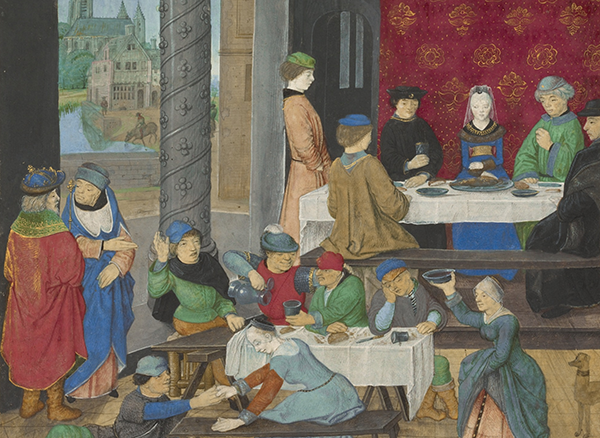We got a kick out of this recent io9 post fact-checking 10 misconceptions about the Middle Ages. Drawing on a particularly awesome r/AskHistorians thread, the post untangles popular myths about the “Dark Ages,” including that peasants were all the same (NOT), and that women never pursued a trade (FAKE).
As manuscripts curators who spend our days studying the visual evidence of the Middle Ages (and our nights watching fantasy shows), we’d like to offer yet more visual ammo to debunk four of our favorite myths.
FALSE: People had horrible table manners, throwing bones and scraps on the floor

The Temperate and the Intemperate, about 1475–80, Master of the Dresden Prayer Book. Flemish. The J. Paul Getty Museum
Pretty much every fantasy/medieval story has that “Scene In A Rowdy Inn” where filthy travelers guzzle beer and gnaw the meat off giant bones. But in the Middle Ages, there were indeed rules for etiquette—some even pulled from the customs of ancient Rome.
This illumination is based on Valerius Maximus’ Concerning Morals and Customs, a compilation of stories about ancient mores and heroes written in the 1st century A.D. You can see two sets of dining experiences, with classist and moral undertones, happening at once in this image. At the top right is the nobility, dining over a white cloth of honor, their perfect posture bordering on stiff. At the front, by contrast, a boisterous bunch of peasants gets wasted.

Nobles being noble

Partying like a peasant

Valerius (the author of the Roman text) shows Emperor Tiberius the danger of intemperance. And don’t miss this dog, who looks a bit lost in the scene.
So yeah: In the Middle Ages there was a clear concept of table manners, at least among the rich. But while the nobles are inherently better-behaved (according to this illustration paid for by nobles, anyway…), the pleasure-loving peasants don’t have it so bad. Also, if you’ve fallen completely off the table, do judgy concepts of table manners even still apply?
FALSE: Men’s clothing was always practical and functional

Detail of The Competition in Sittacene and the Placating of Sisgambis, about 1470–75, Master of the Jardin de vertueuse consolation. French and Flemish. The J. Paul Getty Museum
In a word: leggings.
Extremely wedgie-inducing, leggings-as-pants were the subject of great debate, then as now. In mid-15th-century England there was even a law about who could wear short tunics that revealed the male buttocks. Surprise! Only the rich.
More on this medieval fashion faux-pas here.
FALSE: Medicine was based on pure superstition
Surgeons and doctors existed in the Middle Ages, and while some treatments were a bit scary by today’s standards (bloodletting was a thing), they were quite logical.

Detail of Saint Fiacre and the Shrew Houpdee, 1469, Lieven van Lathem. The J. Paul Getty Museum
Then as now, many medicines were drawn from plants. Saint Fiacre, shown here, was the patron saint of gardeners and disease-sufferers, a handy combo. (Fun fact: hemorrhoids were called “the figs of Saint Fiacre.”) In the story that inspired this illumination, the “hey, you!” lady in the background is so amazed by Saint Fiacre’s green-thumb-slash-healing-powers that she accuses him of practicing witchcraft. But if healing and herbology sometimes seemed suspicious, healers like St. Fiacre were also thought to be doing the work of God.
Practical and logical home remedies, like ointments and bandaging, are also seen aplenty in pictures from the Middle Ages. In this illumination depicting the miracle of Saint Jerome removing a thorn from a lion’s paw, a frightened monk in the background rushes in with a gold bowl of ointment and a semi-sheer bandage. In the foreground, Saint Jerome casually, and elegantly, removes the splinter with a pair of gold tweezers. Just because a miracle is occurring doesn’t mean you shouldn’t stop at CVS.

Detail of Saint Jerome Extracting a Thorn from a Lion’s Paw, second quarter of 15th century, Master of the Murano Gradual, Italian. The J. Paul Getty Museum
Also on the topic of science, in the Middle Ages astrology was hugely important. People at all levels of society were concerned with their star charts, political leaders especially so. From breaking ground for new buildings to waging battle, astrological considerations were taken very seriously. Astrology may seem superstitious to some of us, but it was practiced (some would say, is practiced) much like a science.

Detail of The Trinity, Book of Planets, Anatomical Treatise, Liber synonimorum, shortly after 1464. German. The J. Paul Getty Museum
FALSE: The most powerful military force consisted of armored knights riding into battle
Sure there were mounted members of the military, but more often than not, soldiers had to fight on the ground. A manuscript in our collection, The Flower of Battle, shows all kinds of medieval weapons, armor, and combat tactics. These two pictures show combat with dagger (top) and staff. Check out the scary guy on the left wielding a cave-man-ish club.

Details from Combat with Dagger and Staff, about 1410, Italian. Flower of Battle. The J. Paul Getty Museum.

Combat with staff
Who knows, this might have been the book that taught Gandalf to fight. Because fantasy books ARE REAL…even if authors sometimes get the facts wrong.





Um… Fantasy books are real?? Wha..??